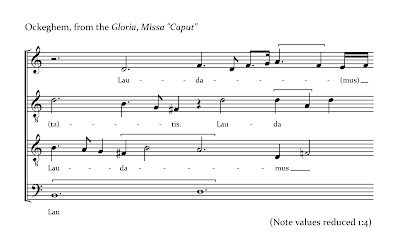Karlheinz Stockhausen: Studie II (1954)
...just three minutes of gentle escape to an alternative acoustic world, one in which the interval of equivalence is not the octave with its ratio of two-to-one, but 5:1, two octaves and a just major third, partitioned into 25 equal parts, extended to create a source gamut of 81 tones, with 193 complex tones composed of spectra with partial tones derived from that gamut, realizing a unified conception of pitch and timbre. The technology then available to the composer made the assembly of complex tones from the superimposition of recorded sine waves difficult, as the combined tones did not "lock" in phase with the character of familiar instrumental and vocal spectra. So, ingeniously, the superimposed tones were played into a real acoustic space, and the set of 193 recordings of these reverberent electro-acoustic tones became the single sound source in the piece. The gentleness of the etude owes a lot to the handwork of Stockhausen's original realisation (which the composer preferred to subsequent, more precise, realisations), and beyond the funkiness of the room-reverberated tones, in every performative parameter - timing, amplitude - there is evidence of "tweaking", making the slightest of adjustments by hand to satisfy the immediate impulses of the ear.
*****
Given Stockhausen's huge catalog, it may seem stingy to select a monophonic three-minute tape piece from the beginning of his career as a "landmark". These landmarks, however, are intended to be about the works themselves, not the representation of catalogs. However, given the fact that I have avoided repeating composers to date — which is increasingly difficult, given the landmark presence in my life of Ives' Second Orchestral Set or the Mozart G minor Quintet, for example —, it might be useful, here, to write something about Stockhausen's catalog in more general terms.
A handful of pieces from the 1950's — the two electronic studies, Gesang der Junglinge, Kontra-Punkte, the first five piano pieces, Zeitmaße and Gruppen, for three orchestras —, have always seemed to me to be remarkable works of musical imagination. I have enjoyed a few pieces since — the piano duo with ring modulation, Mantra, the park music, Sternklang, the piece for two singing harpists, Freude, and a woodwind trio, Balance, to name four — but they haven't erased my sense that Stockhausen's moment, if you will, was in the '50s and that his ideas about music (especially those found in the essay ...how time passes...) and his personal and intellectual connections to contemporary music, science, and society in general, ended then. Much as Varese's music was a "look back to the future"* of the ultra-modernist 1920's, Stockhausen's music now has a similar nostalgic quality. (The gee-wizzish science-fiction element found in Sirius and the Licht operas, combined with the child-like piety in these and in other works doesn't help much either.)
During a recent week with extra reading time on public transport due to a series of rehearsals, I read through volumes 5 & 6 of Stockhausen's Texte zur Musik, which take his work through the first two Licht operas, ca. 1990. The reading is often tough going, not because of the language, but because of the absence of interesting new content with regard to compositional technique; the excitement of discovery that one associates with the earliest work — and which sustained me, as a high schooler without German training, to read through volumes 1 & 2 with a dictionary — is simply no longer active and the constant repetition of his worklist, his various lists of "firsts", the various slights to his person and work, as well as the general overabundance of immodesty (at one point he states that, following Licht, no one will ever think of the days of the week without thinking of his works) are plain tiresome.**
Nevertheless, the texts contain very important elements of the story of a working composer in post-WWII Germany, one for whom, at one point, all of the major institutional supports for his work were in place, only to eventually make major breaks with each of those institutions — including the Darmstadt Summer Courses, the Musikhochschule in Cologne, Universal Edition, Deutsche Grammophon, and the West German Radio —, encouraging or forcing the composer to create alternative institutions, for teaching, publishing, recording, even the rental of instruments, in his own cottage industry. While some of the reasons for the turn to alternative institutions was of practical necessity, I can't help but wonder if the turn, in this particular case, was already an inevitablity due to the nature of the work itself. Much as Studie II existed in a tonal universal without resources common to our own, the specific demands of numerous works by Stockhausen proved to be challenges to performance, teaching, publishing, recording, and broadcasting that lacked sufficient commonality with existing resources and infrastructure.
It has been said that Mozart was the first continental composer to move from court patronage to a freelance existence, composing for a bourgeois audience, but that Beethoven was the first to actually succeed materially as a freelancer. I think that Stockhausen's career took place in a similar transitional era; whether his particular path through this era proves to have been successful — musically or materially — remains to be heard.
_____
* as Heinz-Klaus Metzger and Rainer Riehn named the Varese volume of Musik-Konzepte.
** at one point, in a particularly acute illustration of his growing distance to contemporary society, Stockhausen describes an African-American singer — with whom he worked closely for many years — in racial terms that had already been long unnacceptable in German.



